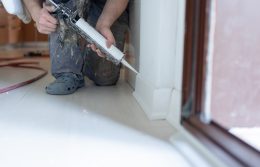Make This Giant DIY Slip-and-Slide
A store-bought slip-and-slide may be convenient, but it’s not the most fun. These slides are rarely over 20 feet long, and riders are lucky to eke out 3 seconds of slide time before reaching the end.
If you’re looking to kick it up a notch, consider building a DIY slip-and-slide with your own two hands. When you go DIY, you’ll have the option to make your slide wider, longer, and a heck of a lot faster. If you’re ready to get started, here’s how to take slipping and sliding to the max. Just remember to make sure the slipping and sliding is happening on purpose! Parents should supervise small children to ensure safety.
Choose the Perfect Spot
To scout a location, look for a grassy area free from rocks, roots, and other debris. You’ll also want to position your slide on a downward slope. If the slip-and-slide is on a totally flat surface, it’s unlikely that riders will gain enough speed to coast the entire length of the slide.
Gather Your Materials
The main ingredient for a DIY slip-and-slide is the slide itself, fashioned from a giant sheet of plastic about 10 feet wide and 100 feet long (everything’s bigger in Texas). Your sheet also needs to be at least 6mm thick; any thinner and you risk a tear that will put a damper on your day of fun. These large plastic sheets are readily available — check home improvement stores and look online.
- You will need: A plastic sheet, a 10’x100′ space, a garden hose, 8 to 10 pool noodles, and 8 ground stakes
- Optional: Baby shampoo
Put It Together
Lay your plastic sheet on the ground and pour a bit of water down the slide. The water should flow to the bottom in a straight line. Reposition and retest until this is achieved, then stake the corners and edges of the slide into the ground.
Next, you’ll need to set up a landing area. The easiest way to do this is to place 5 to 10 pool noodles under the plastic toward the bottom of the slide. These “speed bumps” will help to bring riders to a gentle stop. Stake the noodles in the ground to keep them secure.
If it works with the layout of your backyard, you can also try connecting your DIY slip-and-slide to the deep end of your pool, providing riders with a splash-tastic finish.
Test It Out
Spray your slip-and-slide with a hose, ensuring even coverage. Then, position the hose at the top of the slide, leaving the spigot on a gentle drip to keep the slide wet. Before trying the slide yourself, send down a crash test dummy (maybe a watermelon) to make sure it’s not too fast. If it all looks safe, give it a try yourself. If you need more speed, a thin coating of baby shampoo will make it extra slick.
For a half-hour of setup time and about $50, this is one wild ride. Find a world of more DIY family fun here.
© 2021 Texas Farm Bureau Insurance



